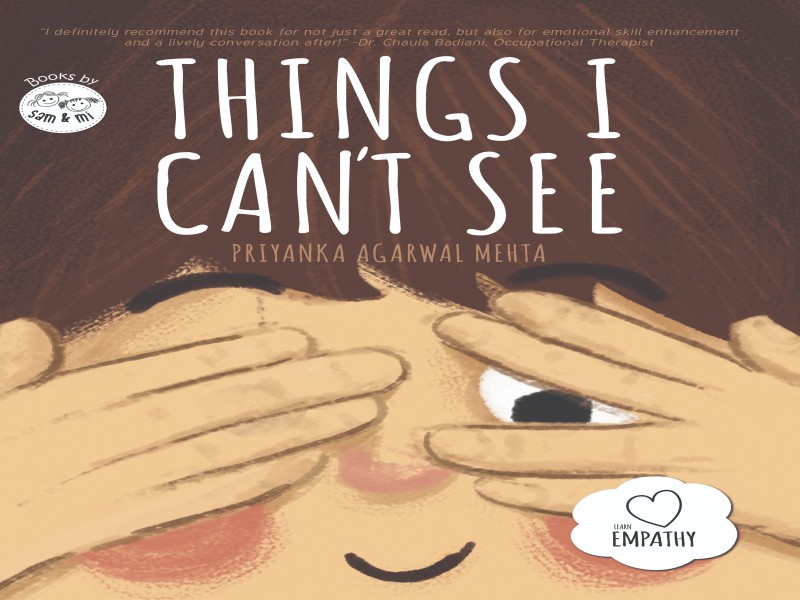No products in the cart.
Sam & Mi’s ‘Things I Can’t See’ makes a splash among kids, educators
Things I Can’t See, a picture book published by Sam and Mi, has resonated widely with children and educators alike. It recently featured in Amazon India’s Top 100 books and continues to hold the #1 spot in Children’s Books on Emotions & Feelings. It reflects a play-based, inquiry-led pedagogy that the National Curriculum Framework for the Foundational Stage (NCF-FS) recommends.
The book features everyday scenes that are open to multiple interpretations. The child is sad – are they hurt or have they dropped their ice-cream cone? The lady is smiling – Did someone tell her a joke or does she just enjoy the beach? The book impels the reader to reflect. It uses visual scanning as a tool to help children share their perceptions and understand those of their parents/ classmates/ teachers. By considering multiple emotional responses to the same scenario, they organically deliberate on the idea that feelings are subjective and context-dependent.
Designed for 3 to 8 year olds, the book serves as a powerful cross-age SEL tool. It has been adopted in CBSE, ICSE and IB classrooms by multiple schools where it is used for assigned summer reading, group discussions, role play, peer-led reading, and emotion-mapping exercises. Other schools use it to spark creative responses by drawing ‘unseen moments’ or having older students buddy-read with younger ones to reflect together.
Dr Chaula Badiani, an occupational therapist and the founder of Research Therapy Centre for Children, writes, “Things I Can’t See is a fun and relatable book for children and parents alike. It is a fantastic read-aloud for quality parent-child time and a great tool for visual perceptual skill development for young readers through experiential scanning for each emotion. I recommend this book not just as a great read, but also for emotional skill enhancement and a lively conversation after.”
After a virtual storytelling session, Elisabeth Morrow School, New Jersey (USA) shared, “Things I Can’t See was a big hit with the children, the principal, and the head of school. Both asked me to send you compliments. They thought the book and discussion was wonderful and perfect for our school.”

Things I Can’t See became an instant favourite because it doesn’t conclude or correct kids; it lets them understand that their world may not be your world. Question it and reason around it. This is what SEL in early childhood should feel like – safe, curious, and gentle, like learning to ride a bicycle or writing your name. Understanding emotions takes time and the journey should be joyful.
It should be noted that the Collaborative for Academic, Social, and Emotional Learning (CASEL) identifies these competencies—particularly empathy, perspective-taking, and communication—as the basis for effective SEL programming (CASEL Framework). Developmental psychologist Robert L. Selman’s theory of perspective-taking underscores this. He notes that children gradually develop the ability to coordinate different social viewpoints. They reflect on their emotions and analyse how others might be thinking or feeling in a given situation. This is an essential cognitive foundation of SEL (Selman, 1980).
To cultivate these capacities, SEL activities must go beyond behavioural correction and labelling emotions. Sam and Mi believes that resources for SEL must help develop the following abilities:
Questioning: Help children attach a “Why” to behaviours, actions, and emotional expressions.
Active Listening: Support the ability to pick up on verbal and non-verbal emotional cues—skills shown to enhance empathy and interpersonal connections (Bodie et al., 2014).
Acceptance: Encourage students to recognise and respect that multiple perspectives and emotional responses co-exist in the same situation.
Traditional curriculum models often struggle for resources that accommodate the fluidity, subjectivity, and emotional nuance required for effective SEL. Thus, educators need multi-use, age-appropriate, development appropriate tools. Tools that may be adapted across contexts to promote critical reflection and engage the emotional and analytical faculties of learners.
Things I can’t See is proving to be an effective tool for educators to impart socioemotional skills, thus aligning with the National Education Policy’s emphasis on introducing Social and Emotional Learning (SEL) in the foundational and preparatory years.
Sam and Mi is a children’s publishing house focused on the age group of 0-8 years. Its books focus on themes of empathy, problem solving and communication. To learn more, visit https://samandmi.com/.
Also read: Three Karnataka schools to offer Australia’s WACE curriculum starting this year















Add comment